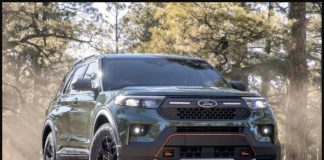A hybrid truck like the full-size GMC Sierra 1500 (and its sister truck, the Chevy Silverado 1500) may be the best hybrid vehicle of all.
Or at least, one of the most sensible hybrid vehicles.
Large trucks, after all, consume a lot more fuel than a compact or mid-size passenger car — the typical “platform” for a hybrid gas-electric powertrain up to now. Anything that makes a guzzleosaurus full-size truck reasonably efficient (which most compact and mid-sized passenger cars already are, even before fitting them with a hybrid powertrain) is arguably a serious improvement. It’s a matter of going from awful to okay — vs. already okay to even better for a compact/mid-sized passenger car hybrid.
The hybrid Sierra 1500 can tickle 20 mpg on the highway and 17-18 mpg around town — excellent economy from a full-size extended cab 4×4 pick-up, especially one packing a 295-hp, 5.3 liter V-8. These figures represent a mileage improvement of about 10 percent overall compared to a non-hybrid 1500 with the 5.3 liter Vortec V-8. GMC claims the Sierra hybrid (and the basically identical Chevy Silverado 1500 hybrid) offer the best in-town fuel efficiency of any large pick-ups currently available.
Hybrid trucks like the Sierra 1500 are also still fully capable, no-compromises trucks — able to do the same work their non-hybrid equivalents can. That includes being able to tow 7,700-lbs. and tackle off-road driving/hard use. (The same heavy-duty suspension package offered on non-hybrid 1500s is also available with the hybrid powertrain). Passenger car hybrids are fragile things — and most of them are compromised in some way, sacrificing performance on the altar of economy.
Not so the Sierra 1500 hybrid.
In fact, you can do more work with the hybrid version of the 1500 than you could with the standard model — thanks to the bonus of a 2,400 watt built-in generator (and integral starter) that’s included with the package. This generator/starter combo can provide 20 amps of 120 volt current through outlets inside the cab and in the bed — enough juice to run a circular saw at a job site or function as an emergency source of power to run essential home appliances during a blackout. You’ll still be able to catch the game — and/or keep the stuff in you fridge from spoiling.
And you can run your TV (or fridge or whatever) for up to 32 hours non-stop on a single tank of gas. Put a fitted cap on the bed with some skylights, perhaps — and maybe some deep pile rugs, a mini-fridge/wet bar — and you’d have a mobile party wagon infinitely more accommodating than your old Astro Turf-lined mid-’80s GMC Caballero. Take it camping — and take all the amenities of home along for the ride.
The other function of the generator/starter is to automatically cycle the powertrain from pure battery power (when the vehicle is stopped or idling) to internal combustion (when the vehicle is moving). This happens almost imperceptibly — with dead silence your only clue that the gas engine has been turned off. The 42 volt lead-acid battery pack kicks in to keep accessories like the radio and air conditioner working while the gas engine isn’t. When the engine’s on, the starter/generator is recharging the batteries for the next cycle. And so on.
This truck is what’s known in the biz as a “mild hybrid” — because it does not actually drive on pure electric power (as, for example, the Toyota Prius and some others do) or use the onboard batteries to “goose” the performance of the gas engine under hard acceleration. The idea is to save energy by keeping the engine from burning up gasoline at idle — whether sitting at a light or just sitting there by the road while you make a cell phone call. If you think about it, many of us spend a whole lot of time in our vehicles not going anyplace at all. That’s a lot of wasted fuel — and a lot of foulness (everything from unburned hydrocarbons to planet-warming carbon dioxide gas) pouring out of our tailpipes into the sky for no good reason. The hybrid cuts down considerably on this needless waste — without inconveniencing us or even asking us to do without AC for a couple of minutes (as you’d have to if you were to just shut off the engine in a regular car or truck).
The other nice thing about hybrid trucks — or at least, this hybrid truck — is that they are relatively inexpensive. Unlike the typical passenger car hybrid — which can cost several thousand dollars more than its non-hybrid equivalent — GMC asks just $1,500 for the hybrid gear, in addition to the cost of the truck itself. My tester — a Sierra extended cab with the SLE2 package that included the 5.3 Vortec V-8, automatic transmission, dual zone AC, Autotrac electronic 4×4 transfer case, Bose premium audio with XM radio and leather trim, etc. — carried an MSRP of $34,690. The additional cost of the hybrid equipment relative to the vehicle cost is comparable to ordering a sunroof or wheel/tire package. No big deal, really.
As some critics have observed, it will probably take years (assuming gas doesn’t spike up to $5 per gallon) to amortize the higher purchase price (typically several thousand dollars higher than the equivalent non-hybrid) of a hybrid passenger car — perhaps longer than the typical buyer might even keep the thing. But it’s not going to take nearly as long to get back $1,500 in lower gas bills driving a full-size truck that’s 10 percent more efficient than it would otherwise be — especially if you do a lot of stop-and-go-type driving, where the hybrid is most efficient.
You also get the psychic benefit of driving a lower-emissions vehicle — since the Sierra produces no harmful pollution when it is “idling” on a battery power alone.
So it’s pretty much a have your cake and eat it, too situation. (The hybrid-specific components even have their own separate — and extended — eight year/100,000 mile warranty.)
If there’s any downside to this truck, it’s only that an even nicer one is waiting in the wings — due sometime later next year as an ’07 model. The next-generation Sierra (and Chevy Silverado) will be based on the architecture of the 2007 Chevy Tahoe (and shared-platform GMC Denali and Cadillac Escalade SUVs), which comes out in early 2006. I’ve driven the ’07 Tahoe and it is an impressive piece of work — from its coil-over shock/aluminum control arms to its Land Rover-level interior. It will be worth the wait — or go ahead and get a great deal on an ’06 while there are still plenty available to choose from (and very likely, some mighty tempting incentive offers).
Either way, you’ll drive home happy — and be using a bit less gas than your buddies while keeping your six packs cold and your power tools humming.
Throw it in the Woods?










I never understood why these didn’t take off. Such a cool idea, and like Eric said it’s a much better deal mpg-wise to improve the worst performers first. Never understood why delivery type medium trucks don’t have this tech. so they can “idle” at a dock while not actually idling. Or for sitting in city traffic. I hope Workhorse and or Via motors are successful and hopefully without gov subsidies.
This article is also an interesting snapshot into a younger Eric Peters 🙂